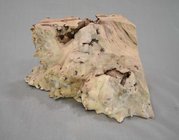Can you successfully stabilized cherry burl with the bark on in Alumilite slow? Or do you have to remove the bark? Thank you.
-
July 2025 Turning Challenge: Turn a Multi-axis Weed Pot! (click here for details) -
Congratulations to Bobby McCarly for "Hemostatmorphodon" being selected as Turning of the Week for July 7, 2025 (click here for details) -
Welcome new registering member. Your username must be your real First and Last name (for example: John Doe). "Screen names" and "handles" are not allowed and your registration will be deleted if you don't use your real name. Also, do not use all caps nor all lower case.
You are using an out of date browser. It may not display this or other websites correctly.
You should upgrade or use an alternative browser.
You should upgrade or use an alternative browser.
Casting Alumilite Slow
- Thread starter Dave Fritz
- Start date
I'm not sure what you are trying to do, but Alumilite slow is a casting resin, not a stabilizing resin. If you are looking to penetrate soft areas to make them stronger then cactus juice is a better option. If you want to create a hybrid object of wood and resin, the Alumilite is a good choice. However, it does not play well with moisture, so your wood must be bone dry. If the bark is tight to the wood after baking to remove all moisture, it will remain when cast. If you want to stabilize the bark, you can use Cactus Juice and then cast the piece in Alumilite.
It is stabilized with Cactus Juice. Is taking off or leaving the bark on purely an design consideration? Has anyone ever stabilized cherry burl with the bark and cast it in Alumilite successfully?
If its not loose it will work. I have found getting the bark off of cherry burl to be a pain compared to something like maple. Lately i have been using a sandblaster with glass beads to clean it up getting the loose bark and dirt off of it. The glass is strong enough to get the soft stuff off but not damage the good wood easily. Here's a piece of maple burl that i picked the bark off of and then sandblasted with glass beads.
Attachments
I would expect that the Cactus Juice would make it difficult to remove the bark at this point, but I do not have direct experience.It is stabilized with Cactus Juice. Is taking off or leaving the bark on purely an design consideration? Has anyone ever stabilized cherry burl with the bark and cast it in Alumilite successfully?
Does the Cactus Juice need to be cured somehow after soaking?
Yes ... I bake it for two or three hours in a toaster oven.Does the Cactus Juice need to be cured somehow after soaking?
Yes. It is a heat cure. Go to the TurnTex website, he has a really good stabilizing end-to-end how-to.Does the Cactus Juice need to be cured somehow after soaking?
Essentially, step 1 is to make sure your piece is dry
2. Cover it in resin in a vacuum chamber and pull a vacuum until it stops bubbling (this is what gets all the air out of the pores in the wood and allows the juice to get into the wood). You have to use vacuum, pressure will not work. You need to get your vacuum down to 29" Hg @ Sea Level minimum. Lower if you can.
3. Break the vacuum and let it soak at least as long as it was under vacuum
4. Wrap each piece individually in foil - this is important, otherwise you will have a single, solid, block after curing
5. Cure. Forget the temperature off the top of my head. You have to leave it in long enough to make sure it fully cures. For a small pen blank or three, I go 2 to 3 hours. Larger pieces go longer. You cannot really 'check' on it without screwing up the curing, so I just let it go until I am certain it has had time to cure.
6. Cool, remove what foil you can, and retrim the blank back to the size/shape you want it to be prior to turning.
If I am stabilizing a batch of blanks, I make sure I have a full day available for the project. Yes, a lot of that time is just waiting, but I do not like to leave the vacuum chamber/pump unattended and I do not like to leave the oven unattended.

